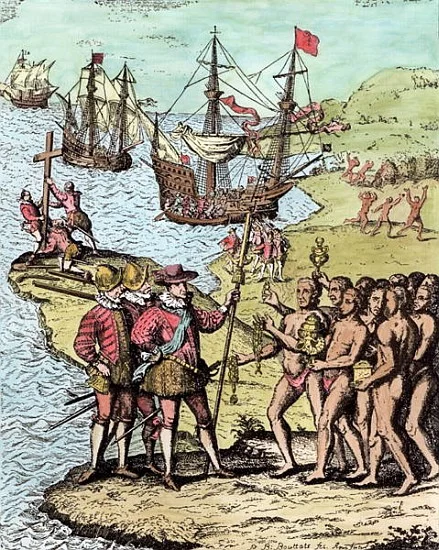Doctrine of Discovery
Summary
The Doctrine of Discovery established a religious, political, and legal justification for colonization and seizure of land not inhabited by Christians. Foundational elements of the Doctrine of Discovery can be found in a series of papal bulls, or decrees, beginning in the 1100s, which included sanctions, enforcements, authorizations, expulsions, admonishments, excommunications, denunciations, and expressions of territorial sovereignty for Christian monarchs supported by the Catholic Church. Two papal bulls, in particular, stand out: (1) Pope Nicholas V issued "Romanus Pontifex" in 1455, granting the Portuguese a monopoly of trade with Africa and authorizing the enslavement of local people; (2) Pope Alexander VI issued the Papal Bull “Inter Caetera” in 1493 to justify Christian European explorers’ claims on land and waterways they allegedly discovered, and promote Christian domination and superiority, and has been applied in Africa, Asia, Australia, New Zealand, and the Americas.
The 1493 Papal decree aimed to justify Christian European explorers’ claims on land and waterways they allegedly discovered, and promote Christian domination and superiority, and has been applied in Africa, Asia, Australia, New Zealand, and the Americas. If an explorer proclaims to have discovered the land in the name of a Christian European monarch, plants a flag in its soil, and reports his “discovery” to the European rulers and returns to occupy it, the land is now his, even if someone else was there first. Should the original occupants insist on claiming that the land is theirs, the “discoverer” can label the occupants’ way of being on the land inadequate according to European standards. This ideology supported the dehumanization of those living on the land and their dispossession, murder, and forced assimilation. The Doctrine fueled white supremacy insofar as white European settlers claimed they were instruments of divine design and possessed cultural superiority.
The significance of the Doctrine continues to be debated. According to David Wilkins, “it is more complicated than just saying the Pope gave European Catholics the rights to colonize and convert. In reality, the absolute denial of Native land rights was replaced less than fifty years later when Charles V… sought the advice of Francisco de Vitoria … as to what the Spanish could legally and morally claim in the New World. Vitoria, in a clear rebuttal to the Pope and the discovery notion, declared that Native peoples were the true owners of their lands.”
The Doctrine of Discovery was the inspiration in the 1800s for the Monroe Doctrine, which declared U.S. hegemony over the Western Hemisphere, and Manifest Destiny, which justified American expansion westward by propagating the belief that the U.S. was destined to control all land from the Atlantic to the Pacific and beyond.
In an 1823 Supreme Court case, Johnson v. McIntosh, the Doctrine of Discovery became part of U.S. federal law and was used to dispossess Native peoples of their land. In a unanimous decision, Chief Justice John Marshall writes, “that the principle of discovery gave European nations an absolute right to New World lands”[1] and Native peoples certain rights of occupancy.
We study the Doctrine of Discovery to listen to voices that have been silenced and disregarded for centuries. These voices tell a frequently overlooked story about the origins of the United States.
COMPELLING QUESTION
How did European explorers and colonial settlers use the Doctrine of Discovery to justify the taking of Native peoples’ land in what became the United States?
SourceS
David Wilkins, “Deconstructing the Doctrine of Discovery,” Indian Country Today Media Network, October 24, 2014.
Pope Alexander VI, “Inter Caetera,” May 4, 1493. Retrieved from http://www.papalencyclicals.net/Alex06/alex06inter.htm
Robert J. Miller, Native America, Discovered and Conquered: Thomas Jefferson, Lewis and Clark, and Manifest Destiny, (Lincoln: University of Nebraska Press, 2008).
United Nations General Assembly resolution 61/295. United Nations Declaration on the Rights of Indigenous Peoples (13 September 2007), available from http://www.un.org/esa/socdev/unpfii/documents/DRIPS_en.pdf (excerpt PDF)
ADDITIONAL RESources
EXCERPTS
“Inter Caetera”
PDF | DOC
“Deconstructing the Doctrine of Discovery”
PDF | DOC
Native America, Discovered and Conquered: Thomas Jefferson, Lewis and Clark, and Manifest Destiny
PDF | DOC
United Nations Declaration on the Rights of Indigenous Peoples
PDF | DOC
HANDOUT
PDF | DOC
Questions & Activities
Read this excerpt of the Bull Inter Caetera issued by Pope Alexander VI.
What is the significance of the fact that the Bull was written in 1493?
What did you learn about the relationship between the Church and the Monarchy?
How does Pope Alexander justify Spain’s dominion over other peoples’ land?
Examine this excerpt from Native America, Discovered and Conquered.
Define the purpose of the Doctrine of Discovery.
How did the Founding Fathers use the Doctrine of Discovery?
Choose one of the ten elements to Discovery and explain how you think it was applied to dispossess Native peoples of their land.
What is the main point David Wilkins makes about the Doctrine of Discovery in this excerpt from his article? How does his perspective compare to Robert J. Miller’s ideas in Native America, Discovered and Conquered?
Read this excerpt from the Preambular to the United Nations Declaration on the Rights of Indigenous Peoples.
Locate sections of the text that make implicit reference to the Doctrine of Discovery and write a short essay explaining the connections you have identified.
[1] Johnson v. M'Intosh, 21 U.S. 543 (1823): https://supreme.justia.com/cases/federal/us/21/543/case.html

